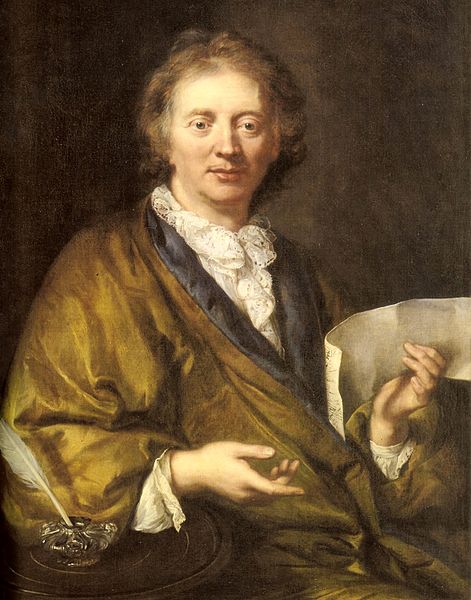<Back to Index>
- Composer and Organist François Couperin, 1668
PAGE SPONSOR

François Couperin (10 November 1668 - 11 September 1733) was a French Baroque composer, organist and harpsichordist. He was known as Couperin le Grand ("Couperin the Great") to distinguish him from other members of the musically talented Couperin family.
Couperin was born in Paris. He was taught by his father, Charles Couperin, who died when François was about 10, and by Jacques Thomelin. In 1685 he became the organist at the church of Saint - Gervais, Paris, a post he inherited from his father and that he would pass on to his cousin, Nicolas Couperin, and other members of the family. In 1693 Couperin succeeded his teacher Thomelin as organist at the Chapelle Royale (Royal Chapel) with the title organiste du Roi, organist by appointment to Louis XIV.
In 1717 Couperin became court organist and composer, with the title ordinaire de la musique de la chambre du Roi. With his colleagues, Couperin gave a weekly concert, typically on Sunday. Many of these concerts were in the form of suites for violin, viol, oboe, bassoon and harpsichord, on which he was a virtuoso player.
Couperin died in Paris in 1733.
Couperin acknowledged his debt to the Italian composer Corelli. He introduced Corelli's trio sonata form to France. Couperin's grand trio sonata was subtitled Le Parnasse, ou L'apothéose de Corelli ("Parnassus, or the Apotheosis of Corelli""). In it he blended the Italian and French styles of music in a set of pieces which he called Les goûts réunis ("Styles Reunited").
His most famous book, L'art de toucher le clavecin ("The Art of Harpsichord Playing", published in 1716), contains suggestions for fingerings, touch, ornamentation and other features of keyboard technique.
Couperin's four volumes of harpsichord music, published in Paris in 1713, 1717, 1722 and 1730, contain over 230 individual pieces, which can be played on solo harpsichord or performed as small chamber works. These pieces were not grouped into suites, as was the common practice, but ordres, which were Couperin's own version of suites containing traditional dances as well as descriptive pieces. The first and last pieces in an ordre were of the same tonality, but the middle pieces could be in other closely related tonalities. These volumes were loved by J.S. Bach and, much later, Richard Strauss, as well as Maurice Ravel who memorialized their composer with Le tombeau de Couperin (Couperin's Memorial).
Many of Couperin's keyboard pieces have evocative, picturesque titles (such as "The mysterious barricades") and express a mood through key choices, adventurous harmonies and (resolved) discords. They have been likened to miniature tone poems. These features attracted Richard Strauss, who orchestrated some of them.
Johannes Brahms's piano music was influenced by the keyboard music of Couperin. Brahms performed Couperin's music in public and contributed to the first complete edition of Couperin's Pièces de clavecin by Friedrich Chrysander in the 1880s.
The early - music expert Jordi Savall has written that
Couperin was the "poet musician par excellence", who
believed in "the ability of Music [with a capital M] to
express itself in prose and poetry", and that "if we enter
into the poetry of music we discover that it carries grace
that is more beautiful than beauty itself".
Only one collection of organ music by Couperin survives, the Pièces d'orgue consistantes en deux messes ("Pieces for Organ Consisting of Two Masses"), the first manuscript of which appeared around 1689 - 1690. At the age of 21, Couperin probably had neither the funds nor the reputation to obtain widespread publication, but the work was approved by his teacher, Michel Richard Delalande, who wrote that the music was "very beautiful and worthy of being given to the public." The two masses were intended for different audiences: the first for parishes or secular churches ("paroisses pour les fêtes solemnelles"), and the second for convents or abbey churches ("couvents de religieux et religieuses"). These masses are divided into many movements in accordance with the traditional structure of the Latin Mass: Kyrie (5 movements), Gloria (9), Sanctus (3), Agnus (2) and an additional Offertoire and Deo gratias to conclude each mass.
Couperin followed techniques used in masses by Nivers, Lebègue, and Boyvin, as well as other predecessors of the French Baroque era. In the paroisses Mass, he uses plainchant from the Missa cunctipotens genitor Deus as a cantus firmus in two Kyrie movements and in the first Sanctus movement; the Kyrie Fugue subject is also derived from a chant incipit. The Mass for couvents contains no plainchant, as each convent and monastery maintained its own, non-standard body of chant. Couperin departs from his predecessors in many ways. For example, the melodies of the Récits are strictly rhythmic and more directional than previous examples of the genre. Willi Apel wrote, "this music shows a sense of natural order, a vitality, and an immediacy of feeling that breaks into French organ music like a fresh wind."
The longest piece in the collection is the Offertoire
sur les grands jeux of the first Mass, which is akin
to an expanded French overture in three large sections: a
prelude, a chromatic fugue in minor, and a gigue-like
fugue. Bruce Gustafson has
called the movement a "stunning masterpiece of the French
classic repertory."
The second Mass also contains an Offertoire with a
similar form, but this Mass is not considered as masterly
as the first: Apel wrote, "In general, [Couperin] did not
expend the same care for this Mass, which was written for
modest abbey churches, as for the other one, which he
himself certainly presented on important holidays on the
organ of Saint - Gervais."